Scientific name
Harmonia octomaculata (Fabricius) (=Coccinella octomaculata Fabricius, Harmonia octomaculata var. arcuata (Fabricius), Ptychanatis octomaculata (Fabricius),
Harmonia arcuata (Fabricius))
Common name
Eight-spotted ladybird
Taxonomic position
Coleoptera: Coccinellidae: Coccinellinae: Coccinellini
Diagnosis
Length 4.6-7.5 mm, width 3.5-5.5 mm. Form elongate oval, moderately convex. Ground
colour orange yellow or red with black markings on pronotum and elytra, highly variable with various degrees of fusion or reduction (see Fig. 9). Elytra with external margins narrow, rounded and thickened; a distinct, concave groove present in humeral region. Males with posterior margin of fifth segment truncate and the sixth shallowly emarginate. Females with posterior margin of fifth segment medially arcuate, sixth with a median tubercle, posterior margin curved. Male genitalia (Figs. 5-7) and female spermatheca (Fig. 4) as illustrated.
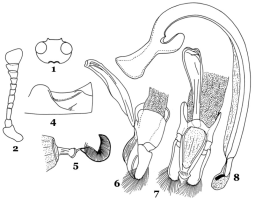 Figs. 1-8. Harmonia octomaculata (F.): 1. Head; 2. Antenna; 3. Postcoxal line on abdominal ventrite I; 4. Female spermatheca; 5-7. Male genitalia: 5. Tegmen, lateral view; 6. Tegmen, ventral view; 8. Sipho. Figs. 1-8. Harmonia octomaculata (F.): 1. Head; 2. Antenna; 3. Postcoxal line on abdominal ventrite I; 4. Female spermatheca; 5-7. Male genitalia: 5. Tegmen, lateral view; 6. Tegmen, ventral view; 8. Sipho.Images
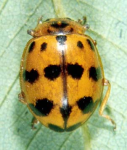
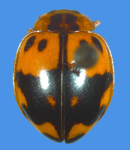
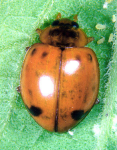

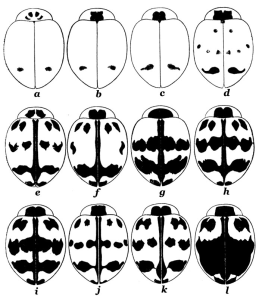 Fig. 9. Variations in color pattern of H. octomaculata (from Kapur, 1954) Fig. 9. Variations in color pattern of H. octomaculata (from Kapur, 1954)
Distribution
Widely distributed almost throughout the Oriental and Australasian regions. India: Very common in peninsular and northeastern regions (Andhra Pradesh; Assam; Karnataka; Kerala; Manipur; Punjab; Tamil Nadu). Myanmar. China. Taiwan. Japan. Southeast Asia. Papua New Guinea. Micronesia. Australia. New Zealand. Hawaii.
Prey / Associated habitat
HEMIPTERA: Adelgidae: Indeterminate adelgids on silver fir. Aphididae:
Acyrthosiphon pisum (Harris), Aiceona litseae Basu & Hille Ris Lambers, Aphis
craccivora Koch, Aphis gossypii Glover, Aphis rumicis Linnaeus, Ceratovacuna
lanigera Zehntner, Geoica lucifuga (Zehntner), Melanaphis sacchari (Zehntner),
Myzus nicotianae Blackman, Myzus persicae (Sulzer), Rhopalosiphum maidis (Fitch), Tuberculatus indicus Ghosh. Cicadellidae: Empoascanara indica (Datta), Nephotettix nigropictus (Stal). Delphacidae: Nilaparvata lugens (Stal), Perkinsiella saccharicida Kirkaldy, Sogatella furcifera (Horvath). Pseudococcidae:
Planococcus citri (Risso). LEPIDOPTERA: Pyralidae: Cnaphalocrocis medinalis (Guenee),
Marasmia patnalis Bradley, Ostrinia furnacalis (Guenee), and Scirpophaga incertulas (Walker). Thysanoptera: Stenchaetothrips biformis (Bagnall).
One of the most common coccinellids in rice ecosystem; also collected on cowpea, maize, sorghum, finger millet, sugarcane, melon, cabbage, cauliflower, pigeonpea, tobacco, Cassia auriculata, Crotolaria mucronata, and Quercus serrata. Attracted to light.
Seasonal occurrence
Collected during March-August and October-December from southern and northeastern India.
Natural enemies
Hymenoptera: Braconidae: Dinocampus coccinellae (Schrank); Encyrtidae: Homalotylus flaminius (Dalman); Acari: Coccipolipidae: Coccipolipus sp.
References
- Kapur, A.P. 1954. Contribution to a knowledge of the fauna of Manipur State,
Assam. Records of the Indian Museum, 52(II-IV): 313-348.
- Pope, R.D. 1989. A revision of the Australian Coccinellidae (Coleoptera). Part I. Subfamily Coccinellinae. Invertebrate Taxonomy 3 (1988): 633-735.
- Puttarudriah, M. & Channabasavanna, G.P. 1953. Beneficial coccinellids of Mysore-I. Indian
Journal of Entomology 15: 87-96.
- Puttarudriah, M. & Channabasavanna, G.P. 1956. Some beneficial coccinellids of Mysore. Journal
of the Bombay Natural History Society 54: 156-159.
- Fauna Japonica. Coccinellidae (Insecta: Coleoptera). Academic Press of Japan. 340 p.
- Sasaji, H. 1977. Larval characters of Asian species of the genus Harmonia Mulsant. Memoirs of the Faculty of Education, Fukui University Series II 27: 1-17.
|